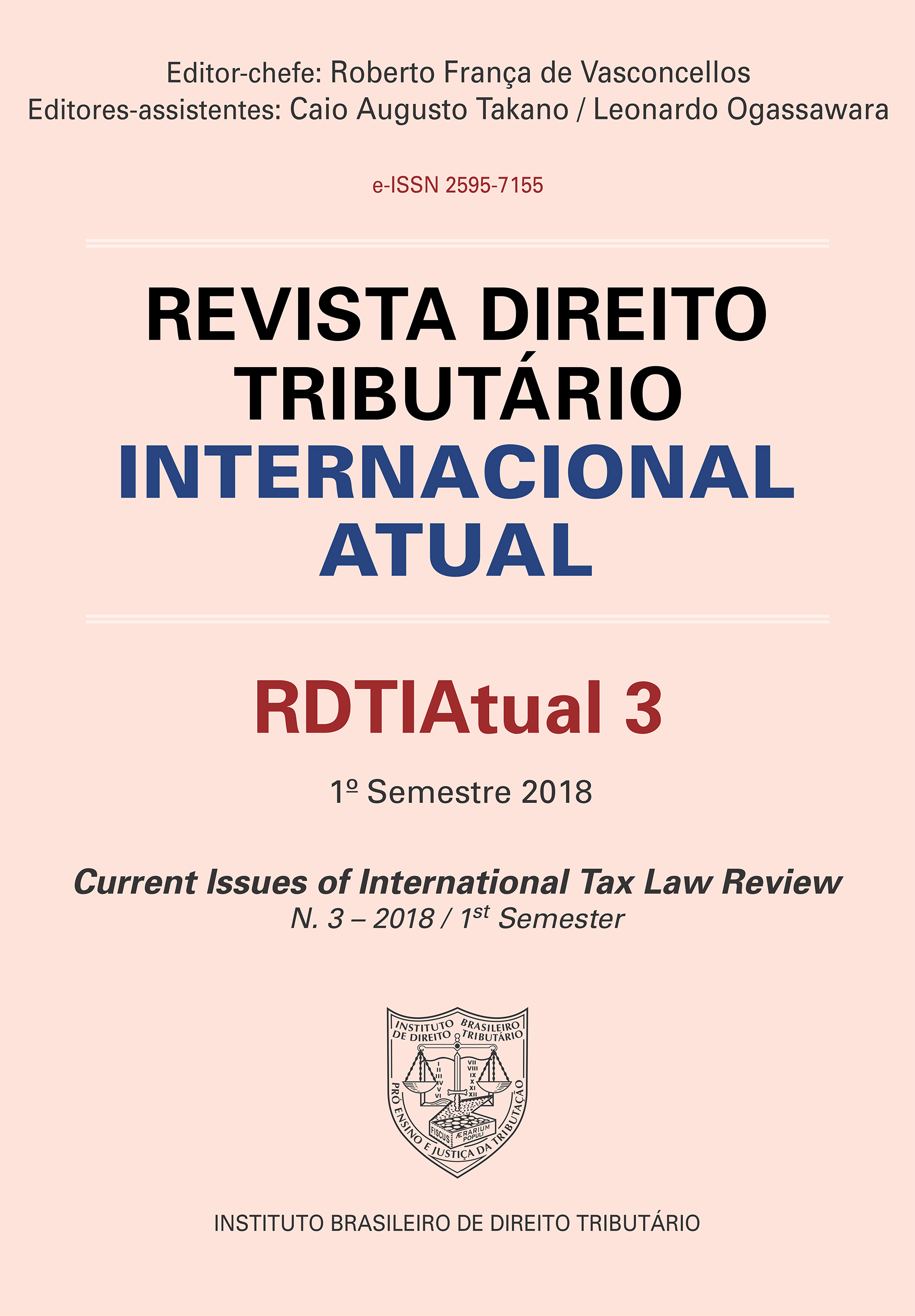The Arm’s Length Standard in the International Tax Regime
Methods, Problems and Proposals
DOI:
https://doi.org/10.46801/2595-7155-rdtia-n3-4Palavras-chave:
preços de transferência, arm’s length, comércio internacional, empresas multinacionais, transferência de lucrosResumo
This essay depicts the arm’s length consolidation as an international standard, the issues involving its implementation and solution propositions. For such, the study begins from the premise that there is an international tax regime as part of the international law and that transfer pricing, along with the arm’s length standard, displays a manifested example of this thesis. It is noted, through the undertaken historical overview, the international adoption of such standard. Strengthening the idea, transfer pricing methods pertained to the arm’s length principle are scrutinized, firstly the so-called traditional transaction methods, emphasizing comparability and secondly the transactional profit methods, in which the comparison between controlled transactions is still present, though flexibly. Furthermore, the existence of conceptual and practical problems surrounding the standard’s implementation are identified, especially the lack of ideal comparables. Finally, the essay presents solution propositions. Some within the standard, through the adoption of new transfer pricing methods and others apart from the arm’s length, indicating inclusively, its clash.
Referências
AMARAL, Antônio Carlos Rodrigues do. Imposto sobre o Valor Agregado – IVA; Value Added Tax – VAT: Brasil – Mercosul – União Européia. São Paulo: Rumo e Academia Brasileira de Direito Tributário, 1995.
______. Tributos e preços de transferência. In: SCHOUERI, Luís Eduardo; e ROCHA, Valdir de Oliveira (coords.). Tributos e preços de transferência. São Paulo: Dialética, 1999. v. 2.
AVI-YONAH, Reuven S. International tax as international law: an analysis of the international tax regime. New York: Cambridge University Press, 2007.
______. The rise and fall of arm’s length: a study in the evolution of U.S international taxation. University of Michigan Law School Program in Law and Economics Program in Law and Economics Archive: 2003-2009 Paper Series n. 73, 2007. See: .
______. Between formulary apportionment and the OECD guidelines: a proposal for reconciliation. University of Michigan Law School Program in Law and Economics Archive: 2003-2009 Paper Series n. 102, 2009, at 3. See: .
______; RING, Diane M.; and BRAUNER, Yariv. U.S. international taxation. Cases and materials. 3. ed. New York: Foundation Press, 2005.
______; CLAUSING, Kimberly. A proposal to adopt Formulary Apportionment for corporate income taxation: the Hamilton Project. University of Michigan Law School Program in Law and Economics Archive: 2003-2009 Paper series n. 70, 2007. See: .
______; and BENSHALOM, Ilan. Formulary apportionment – myths and prospects. University of Michigan Law School Program in Law and Economics Paper series n. 28, 2010. See: .
BARRETO, Paulo Ayres. Imposto sobre a Renda e preços de transferência. São Paulo: Dialética, 2001.
BRAUNER, Yariv. An international tax regime in crystallization – realities, experiences, and opportunities. Public Law and Legal Theory Working Papers Series, Research Paper n. 43. NYU School of Law – Working Draft, 2002. See: <http://www.ssrn.com>.
______. “O valor segundo o espectador: a avaliação de intangíveis para fins de preços de transferência”. In: SCHOUERI, Luís Eduardo (coord.). Tributos e preços de transferência. São Paulo: Dialética, 2009. v. 3.
COOPER, Joel; FOX, Randall; LOEPRICK Jan; and NOHINDRA, Kenal. Transfer pricing in developing economies. Washington: World Bank, 2016.
FRANCESCUCCI, David L. P. The arm’s length principle and group dynamics – Part 1: the conceptual shortcomings. International Transfer Pricing Journal. Amsterdam: IBFD, Mar./Apr. 2004.
______. The arm’s length principle and group dynamics – Part 2: solutions to conceptual shortcomings. International Transfer Pricing Journal. Amsterdam: IBFD, Nov./Dec. 2004.
GREGÓRIO, Ricardo Marozzi. Preços de transferência – arm’s length e praticabilidade. Série Doutrina Tributária v. V. São Paulo: IBDT/Quartier Latin, 2011.
HAMAEKERS, Hubert. Arm’s lenght – how long? International Transfer Pricing Journal. Amsterdam, IBFD, Mar./Apr. 2001.
HELLERSTEIN, Walter. The case for formulary apportionment. International Transfer Pricing Journal. Amsterdam: IBFD, May/Jun. 2005.
NAVARRO, Aitor. Transactional adjustments in transfer pricing. Amsterdam: IBFD, 2017.
OECD. Report on the attribution of profits to permanent establishment. Jul. 2008. See: <http://www.oecd.org>.
______. Transfer pricing guidelines for multinational enterprises and tax administrations. Paris: OCDE, 2010.
SADIQ, Kerrie. Unitary taxation – the case for global formulary apportionment. Bulletin for International Fiscal Documentation. IBFD, Jul. 2001.
SCHOUERI, Luís Eduardo. Preços de transferência no direito tributário brasileiro. 2. ed. São Paulo: Dialética, 2006.
______. Validade de normas internas contrárias a dispositivos de acordos de bitributação no direito e na prática norte-americana. Revista Tributário Atual n. 13. São Paulo: Resenha Tributária, abril 1994.
______. Princípios no direito tributário internacional: territorialidade, fonte e universalidade. In: FERRAZ, Roberto (coord.). Princípios e limites da tributação. São Paulo: Quartier Latin, 2005.
US treasury regulations under Section 482. See: <http://www.gpo.gov>.
US Model income tax convention of November 15, 2006.
XAVIER, Alberto. Direito tributário internacional do Brasil. 6. ed. Rio de Janeiro: Forense, 2005.
Publicado
Como Citar
Edição
Seção
Licença

Este trabalho está licenciado sob uma licença Creative Commons Attribution-NonCommercial-ShareAlike 4.0 International License.
O autor (ou coautor) declara que o artigo submetido à avaliação, que segue em anexo, é de sua autoria, e inédito, comprometendo-se a não publicar este artigo em qualquer outro meio, impresso ou digital, mantendo a exclusividade para a Revista Direito Tributário Internacional Atual, cedendo, em caso de aprovação do trabalho, os direitos autorais à Revista para fins de publicação do trabalho nesta edição.





